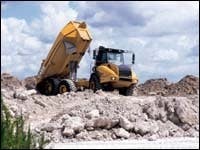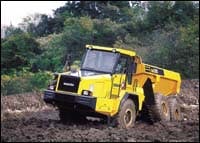- Average ADT Costs
- Basic Articulated-Dump-Truck Specs
- Moxy
- Komatsu
- John Deere
- Volvo
- Caterpillar
- Terex
- Case
- JCB
Sales of articulated dump trucks in North America grew 44 percent in 2004 and are expected to increase another 15 percent this year. It's not a flash in the pan. Construction Equipment's Universe Studies indicate that the total number of artic trucks in the United States has grown more than 70 percent in ten years, and the number of firms that own them has increased 37 percent.
The population of hydraulic excavators has grown faster than ADTs since 1999. Skid-steer loaders have not quite kept pace. But the supply of articulated haulers is curious because of the recent decline in brands competing for its growing sales.
New Holland and Link-Belt abandoned the ADT business within the past 18 months, even as Case added two important models (35-ton and 40-ton machines) built by the CNH joint venture with Astra. Hitachi bowed out in North America years ago.
Of course the reasons for these changes are complex, but the background music, as always, is economic. The key difference between ADTs and other equipment-industry market tigers is that there are fewer than 10,000 of them at work here. That's a fraction of the excavator market — where the population is greater than 160,000 — or skid-steer loaders, with about 300,000 units working in construction. There are too few ADT sales to go around, especially to support brands that have marketing alliances with companies who continue to sell articulated trucks in North America.
The eight manufacturers offering articulated haulers in North America today are doing a masterful job of product differentiation, each striving for the upper hand in what appears to be a marketing dogfight. The battle is in close quarters. Virtually the entire market is confined to just four size classes — 25-, 30-, 35- and 40-ton trucks. JCB alone markets ADTs rated at 14, 18 and 22 tons. Meteoric growth of the ADT market raises the stakes considerably. With list prices for these machines averaging about $12,000 per ton of hauling capacity, there's real money at stake.
The ADT's ability to carry loads quickly, and over rough terrain, fuels the category's growth even while it challenges the buyer's economics. You invest $350,000 or $450,000 in a truck to use when haul roads are bad. They have top speeds, loaded, in the neighborhood of 35 miles per hour. They tend to get broken. Their rough life results in residual values somewhat lower than other machines of similar investment. So the unique application directs many ADTs to the rental fleets.
"About 80 to 90 percent of 35- and 40-ton ADTs are rentals for the first three years of their life," says Dave Wolf, product marketing manager at Case. "It's probably because of the initial cost getting into them, and a lot of it has to do with jobsites. The contractor needs them for a short period of time on a certain job, and then they move on."
Conditions on the next job may not demand an ADT. But you can afford to use an ADT on less-than-demanding conditions if the overall investment was not so steep. Recent product developments suggest that manufacturers are striving to improve reliability and residual values.
Caterpillar redesigned its rear suspension mounts with more steel and shaped rate plates, intending to improve reliability and durability of this crucial part. The front driveline in Case's new 35- and 40-ton trucks routes power directly from a limited-slip differential on the transmission to the front wheel ends, eliminating a driveshaft. Moxy's new MT41 is designed with an additional 3,000 pounds of machine weight than the truck it replaced, even though the engine is smaller by two liters.
In the past two years, wet-disc brakes have become universal on 40-ton ADTs, and transmission retarders have become nearly as common. Huge braking demand of the biggest class of trucks and horrible operating conditions made dry discs (which are used on most smaller ADTs) a maintenance problem. Case and Moxy's new 40-ton trucks were both introduced with those lines' only sealed, oil-cooled brakes, and Terex upgraded the TA40 with them. Cat, Deere, Komatsu and Volvo have used wet-disc brakes for years.
Despite widespread adoption of a few important features, though, competing trucks are fairly unique. For example, in many other types of equipment you find the same Cummins or Cat engines used in several brands. But each of the seven pairs of trucks in the 35- and 40-ton classes is powered by a unique diesel engine. Engines from Case/Iveco, Detroit Diesel, Komatsu, Mercedes Benz, Volvo, Scania, and Cat are represented. Case and Terex use the same Cummins models in their 25- and 30-ton trucks, but at different horsepower ratings.
All the ADTs on the market run automatic transmissions, and ZF drivelines would be nearly universal among ADTs if not for the integrated manufacturers (Caterpillar, Komatsu and Volvo) building their own engines, transmissions and axles. Caterpillar and Volvo choose planetary-style transmissions for their trucks but Komatsu breaks ranks with the integrated manufacturers, claiming that its countershaft transmissions require 30 percent fewer parts.
All the manufacturers that assemble drivelines from OEM-supplied components use ZF countershaft-type gearboxes, except John Deere. Deere chooses ZF planetary-type transmissions for its 25- and 30-ton trucks and Allison World planetaries for its 35- and 40-ton trucks.
Which is the best combination of engine and transmission? That's a judgment that might best be made at the seat of the operator's pants. Low-emissions diesels now have electronic-fuel-injection controls that can be integrated with electronic-control systems on a powershift transmission's hydraulic clutches. In a sense, the engine and transmission cooperate, and the control systems adjust engine speed and clutch pressure to make the smoothest possible shifts at the right times to avoid interrupting power to the wheels.
Suspension designs may be the most-varied feature in the ADT market. Each manufacturer seems to have a different philosophy in using A-frames, multiple linkages, or torsion tubes and combining laminated steel-and-rubber mounts with hydraulic shock absorbers and nitrogen-charged accumulators. It's another one of those performance features that may be most measurable by how the truck feels from the operator's seat.
That doesn't mean suspension performance should be taken lightly. It determines how productive ADTs can be in bad conditions. How well the suspension soaks up impact can also be the key to a truck's reliability and, inevitably, its resale value.
| Web Resources | ||
| Case www.casece.com | ||
| Caterpillar www.cat.com | JCB www.jcbna.com | |
| John Deere www.deere.com | Komatsu www.komatsuamerica.com | |
| Moxy www.moxytrucks.com | Terex www.terexca.com | |
| Volvo www.volvoce.com | ||






